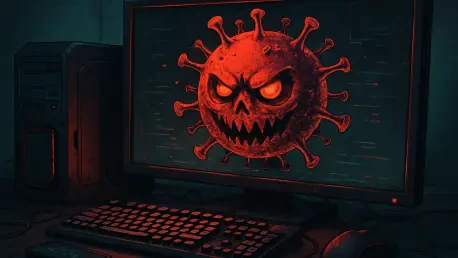In an alarming turn of events within the gaming community, a popular 2D platformer game, known for its engaging mechanics and vibrant community, has become the latest vehicle for a dangerous cybersecurity threat, exposing hundreds of unsuspecting users to severe risks. Released earlier this year by Genesis Interactive, this game initially garnered widespread acclaim among players on a major digital distribution platform. However, a recent patch update, rolled out just a month after its debut, has been exploited by malicious actors to distribute sophisticated malware. This incident has put players at risk of data theft and system compromise. As gaming platforms continue to grow in popularity, they are increasingly becoming prime targets for cybercriminals who exploit the trust users place in routine updates. This case serves as a stark reminder of the evolving dangers lurking in the digital entertainment space and raises urgent questions about the security measures protecting gamers worldwide.
Emerging Threats in Gaming Platforms
The Rise of Malware in Trusted Updates
The gaming industry has witnessed a disturbing trend where trusted software updates are being weaponized to deliver harmful payloads to unsuspecting users. In the case of this particular 2D platformer, a patch identified as Build 19799326, released a month after the game’s launch, bypassed initial security screenings on a widely used distribution platform. This allowed cybercriminals to embed a complex malware strain that targets high-value data, such as cryptocurrency wallet details, browser credentials, and gaming account information. Such attacks are not isolated; similar incidents involving other games like PirateFi and Chemia reveal a systemic vulnerability in the ecosystem of digital distribution platforms. The growing sophistication of these threats indicates a shift in focus among attackers, who now prioritize comprehensive data theft over mere system disruption, exploiting the frequent update cycles that gamers rely on for enhanced gameplay experiences.
Exploitation of User Trust
A critical factor enabling these cyberattacks is the implicit trust users place in updates from legitimate platforms. Gamers often download patches without hesitation, assuming they are safe and necessary for optimal performance. This trust was shattered in the recent incident, where the malicious update appeared as a routine fix, seamlessly integrating into the gaming environment. Once installed, the malware initiated a multi-stage attack, beginning with reconnaissance to assess the system’s defenses and culminating in the extraction of sensitive personal and financial information. Security researchers have noted that the scale of targeted data—from gaming credentials to banking details—demonstrates the extensive reach of such campaigns. The challenge lies in educating users to exercise caution without disrupting the seamless experience that digital platforms strive to provide, highlighting a delicate balance between usability and robust security protocols.
Technical Depth of the Malware Attack
Multi-Stage Infection Mechanism
Delving into the technical intricacies of this malware reveals a highly sophisticated, three-stage infection process designed to evade detection and maximize damage. It begins with a seemingly harmless batch file named game2.bat, which performs initial reconnaissance by collecting IP and location data through legitimate services while scanning for installed antivirus software. This information helps the malware tailor its approach to the target system’s defenses. Subsequent steps involve extracting critical gaming account details and uploading them to a remote command and control (C2) server. Later stages deploy additional scripts and executables, such as Client-built2.exe—a Python-compiled backdoor—and Block1.exe, which contains the StealC information stealer. These components establish persistent communication with the C2 infrastructure, enabling the continuous theft of data from popular browsers like Google Chrome and Microsoft Edge, all while remaining under the radar of standard security measures.
Advanced Evasion Tactics
Beyond its initial infection mechanism, this malware employs advanced tactics to maintain stealth and complicate detection efforts. One notable method includes adding its directory to the exclusion list of Microsoft Defender, effectively bypassing a primary line of defense on many systems. Additionally, it uses outdated RC4 encryption to obscure its operations, making it harder for security tools to decipher its activities. The use of password-protected ZIP archives to conceal payloads during download further hinders early identification by antivirus programs. As highlighted by analysts from a leading cybersecurity firm, the malware’s ability to operate undetected within a trusted update underscores the limitations of current security mechanisms. This level of sophistication signals an escalation in gaming-related threats, necessitating urgent improvements in how platforms screen and verify updates before they reach end users.
Implications and Future Safeguards
Strengthening Platform Security
Reflecting on this incident, it becomes evident that digital distribution platforms must prioritize enhanced security screenings to prevent similar breaches in the future. The exploitation of a routine patch to deliver malware exposed significant gaps in the verification processes of even the most reputable platforms. Cybersecurity experts have called for the implementation of stricter update validation protocols, including real-time monitoring of patch contents for malicious code. Collaboration between game developers, platform operators, and security professionals is essential to create a fortified defense against such insidious threats. While overly stringent measures risk disrupting legitimate updates and user experience, a balanced approach incorporating advanced threat detection tools could mitigate risks without compromising accessibility, ensuring gamers remain protected in an increasingly hostile digital landscape.
Empowering Users Against Threats
Looking back, the incident also underscored the importance of user awareness as a critical line of defense against cyber threats. Educating gamers on the risks associated with automatic updates and encouraging the verification of patch sources could significantly reduce exposure to malware. Platform providers should consider integrating user-friendly alerts or prompts that flag unusual update behaviors, empowering players to make informed decisions. Additionally, promoting the use of robust antivirus software and regular system scans can help detect and neutralize threats before they inflict harm. As cybercriminals continue to refine their tactics, fostering a culture of vigilance among users, alongside systemic improvements, proves vital in addressing the challenges posed by this breach. The lessons learned from this event must drive collective action to safeguard the gaming community against future attacks.









